Deconstructing the Icon: Popular and Academic (Mis)Conceptions of the Cinematic Jesus †
Abstract
1. Introduction
2. Academic Perspectives
2.1. Absence of Knowledge
2.2. Why We Want Knowledge
2.3. What We Know
2.4. How Do We Know Today’s Cinematic Jesus?
3. The Question and the Approach to the Question
4. Two Generations of Jesus at the Movies
- 1988
- Last Temptation of Christ (97)
- The first film to be encountered in the Box Office Mojo database after 1984 was The Last Temptation of Christ, released in theaters in August of 1998. The role of Jesus was played by Willem Dafoe, an American actor. As the film was a drama about the life of Christ, Dafoe’s portrayal is prominent in the film (Figure A1).
- 1992
- Bad Lieutenant (157)
- Bad Lieutenant was a contemporary drama released in 1994. It starred Harvey Keitel in the role of a police officer investigating the rape of a nun. In one short scene from the film, Keitel’s character is in a church and has a vision of Jesus, played by American actor Paul Hipp. Hipp’s Jesus is shown in wide angle, with no medium shots or close-ups other than a brief moment where Keitel’s character crawls toward him. When the character kisses the savior’s feet, those are shown in close-up, revealing the nail scars. When the cop raises his eyes to look at Jesus, the apparition has disappeared (Figure A2).
- 1999
- Superstar (70)
- Superstar was a comedy about Mary Katherine Gallagher, a recurring character from the skit television show Saturday Night Live. It began its box office run in the fall of 1999. Oddly, the scene here bore similarities to that in Bad Lieutenant, in that it was very short and dealt with a vision of Christ by a contemporary character. In this instance, it was comical, though. Mary Katherine, in the midst of praying, briefly saw Jesus appear to talk to her in person. Will Ferrell–an American actor and SNL alumnus–played the role of Jesus. It should be noted that in this humorous movie, Ferrell also played the role of Sky Corrigan, the most popular boy in Mary Katherine’s school (Figure A3).
- 2000
- Dracula 2000 (106)
- Dracula 2000, which arrived at theaters that year in the calendar, was a horror film about the eponymous character and contemporary vampires in New Orleans. A distinctive feature of this rendition of the horror staple is a backstory suggesting the lead character was not originally a Romanian prince from the 15th century. Rather, he was Judas Iscariot, the apostle who betrayed Christ. This is played out in a very short scene of the film where Judas kisses Jesus at the last supper. Canadian actor David J. Francis played Christ, but was only on screen for a few seconds (Figure A4).
- 2003
- The Gospel of John (199)
- Unlike the previous entry, The Gospel of John presented lengthy, recurring images of what the director thought Jesus to be like. It was shown in theaters in the fall of 2003. As the title suggests, this film attempted to encapsulate one of the four biblical accounts of Jesus’s life. The actor who played Christ, Henry Ian Cusick, was born in Peru to a Peruvian mother and Scottish father (Figure A5).
- 2004
- The Passion of the Christ (3)
- As with The Gospel of John, The Passion of the Christ retold the biblical account of Jesus, but focused primarily on his final days, from his betrayal to his crucifixion. American actor Jim Caviezel played the role of Jesus. The film had a lengthy theatrical release from February through May of 2004 (Figure A6).
- 2014
- Heaven is for Real (33)
- Heaven is for Real was a contemporary drama based on a New York Times bestseller, which told the story of a young boy’s near-death experience. In the film version released in 2014, the boy had a vision of himself sitting in a church being visited by Jesus. As in Bad Lieutenant, the scene was very brief (under one minute) and Jesus was never shown in a close-up. In fact, most of the scene was shot from behind the actor playing Jesus, or was backlit, so that the image was mostly a silhouette. IMDB listed Mike Mohrhardt for this role, but very little online information is available about the actor (Figure A7).
- 2014
- Son of God (53)
- Son of God was another cinematic version of the gospel. Its box office premiere was in 2014. In many ways similar to the Gospel of John, it covered the life of Christ from his teaching ministry to his crucifixion and resurrection. So, the portrayal provided by Portuguese actor Diogo Morgado took up much of the screen time. As with the 2003 gospel retelling and The Passion of the Christ, viewers saw a lot of images portraying the physical features of Jesus (Figure A8).
- 2016
- Risen (77)
- Risen was a drama that used elements of the biblical story woven into fictional accounts of other characters. It reached theaters in the winter of 2016. The protagonist was Clavius, a Roman soldier assigned to investigate the cause of Jesus’ empty tomb after the crucifixion. The part of Christ was played by Cliff Curtis, a New Zealander. Though Clavius was the character portrayed most explicitly throughout the movie, Jesus was visualized clearly in scenes of miracles, the crucifixion, and at a gathering of the disciples after the resurrection (Figure A9).
- 2016
- Young Messiah (162)
- The Young Messiah was another extra-biblical tale. The film was based on a novel by American fiction writer Anne Rice. As the title indicates, the movie’s attention was exclusively on Jesus as a child, specifically, seven years old. British actor Adam Greaves-Neal played the lead role. The film was released in 2016 (Figure A10).
- 2016
- Ben Hur (99)
- Ben-Hur was a 2016 adaptation of Lew Wallace’s 19th-century novel of the same name. The book had previously been filmed several times, most prominently by MGM over fifty years earlier. The tale was of a young man in Israel at the time of Christ who was wronged and sought revenge. Most of the plot was about the title character, but he had several encounters with Jesus during his life. The latter was played by Brazilian actor Rodrigo Santoro, who spent a significant amount of time on screen (Figure A11).
- 2017
- The Shack (49)
- Released in 2017, The Shack was a contemporary tale of a man who experienced a series of traumatic events in his life, including the kidnapping of his young daughter. He receives a mysterious letter asking him to return to the shack, the place where his daughter was presumably killed. Finding no answers there, he is invited to a nearby home where he meets three strangers, characters who represent God the Father, the Holy Spirit, and Jesus, the last played by Israeli actor Avraham Aviv Alush. Though the film clearly communicated that the Alush character is the same Jesus spoken of in the Bible, his attire and communicative style (portrayed throughout much of the film) were very contemporary (Figure A12).
- 2022
- The Chosen Season 3: Episodes 1 and 2 (59)
- These episodes of The Chosen are an unusual entry here. As the term “episode” implies, they were created as part of a series of television Biblical dramas. Given the size of its audience via streaming service and the success of faith-based films at the box office, some segments were released in theaters. Jonathan Roumie, who has Syrian/Lebanese heritage, played Jesus, prominent in the series. Several other episodes were released after this initial attempt and also earned places on the BOM list (Figure A13).
- 2024
- The Book of Clarence (120)
- This film by singer and filmmaker Jeymes Samuel was released in January 2024. It was about a first-century citizen of Jerusalem who pretended to be a Messiah for the purpose of overcoming financial problems. During his escapades in the city, this character, Clarence, meets Jesus of Nazareth. The latter was played by Nicholas Pinnock, a British actor of Jamaican descent (Figure A14).
5. Discussion
Funding
Institutional Review Board Statement
Informed Consent Statement
Data Availability Statement
Conflicts of Interest
Appendix A
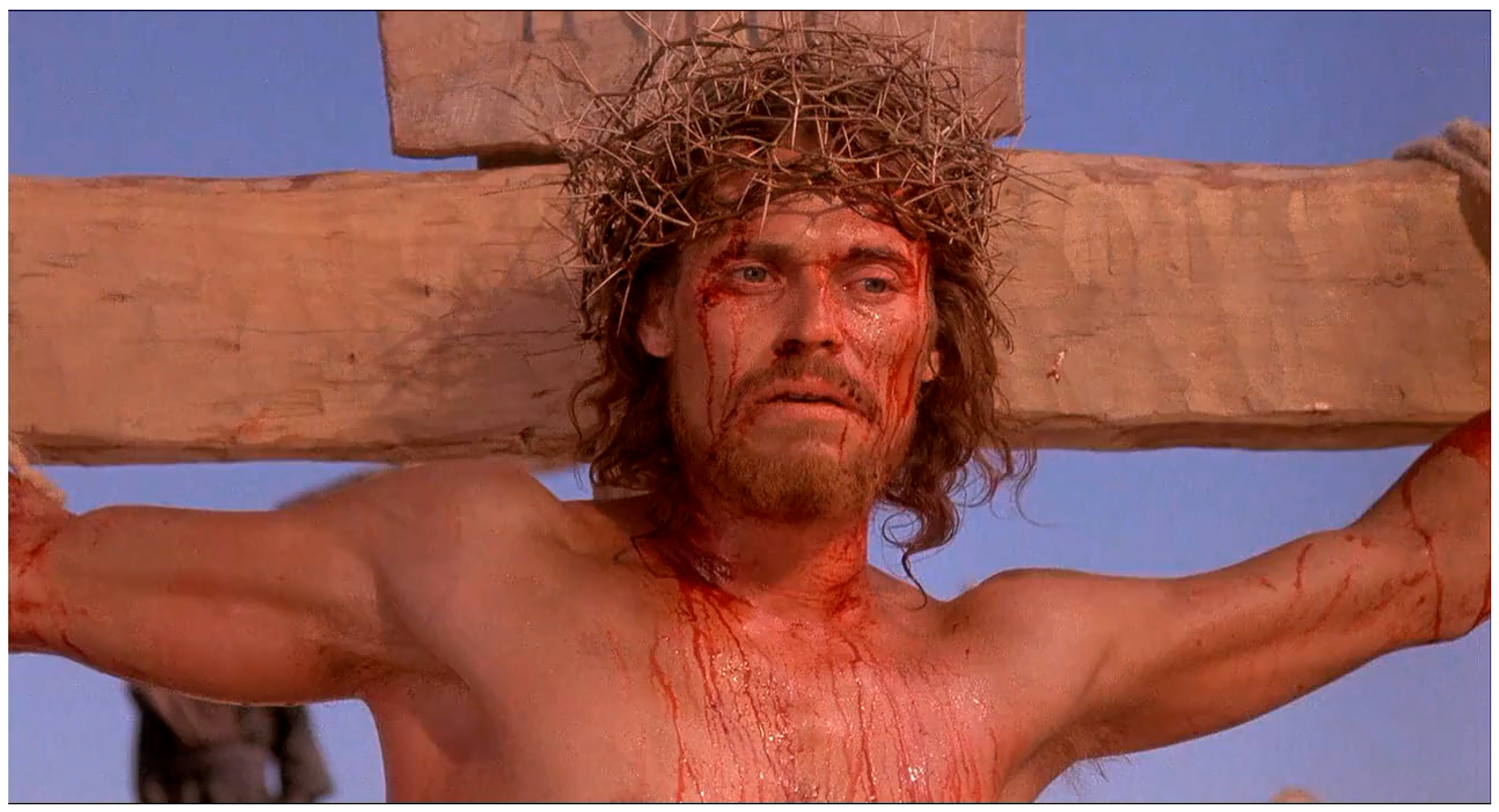
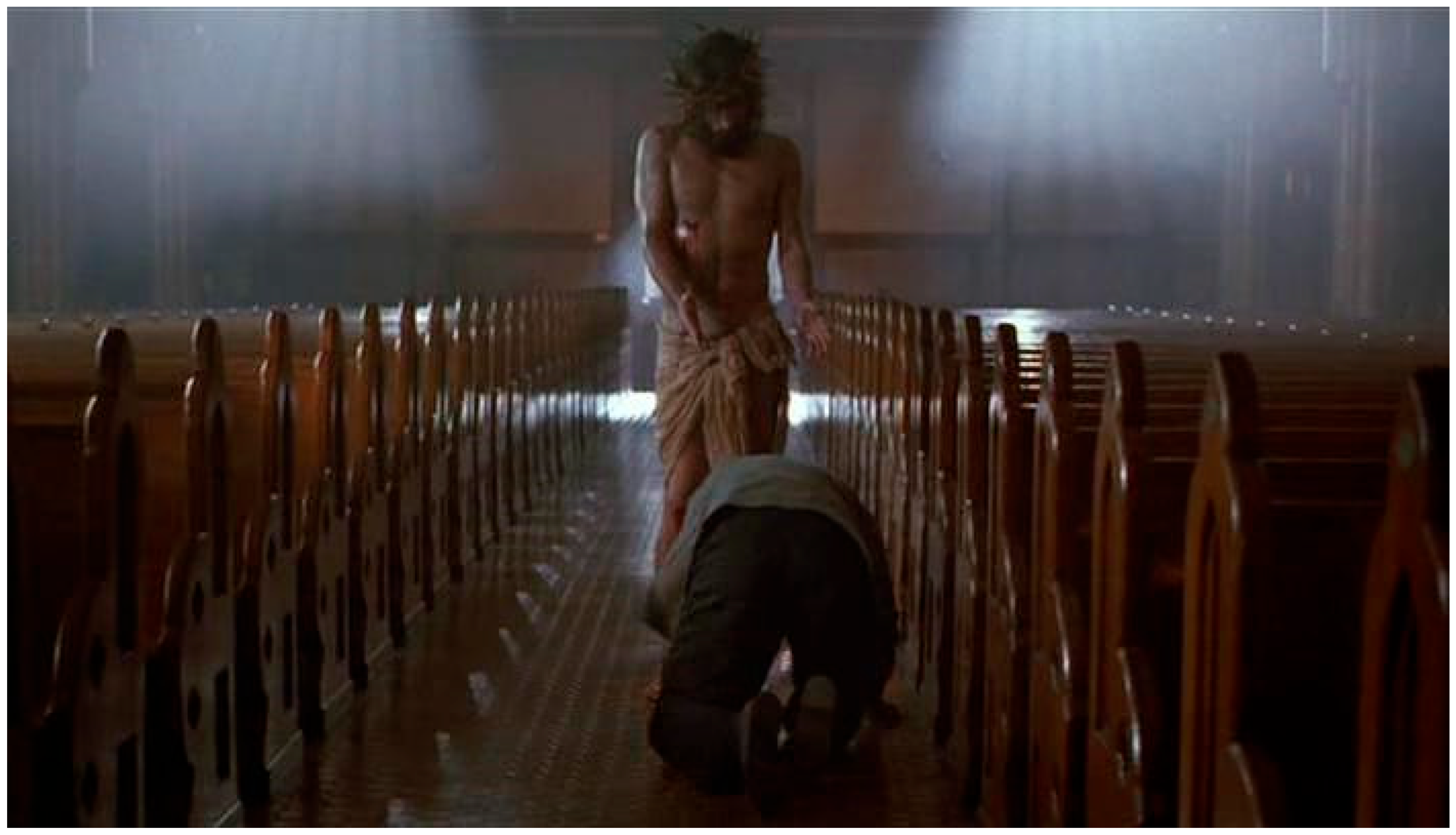
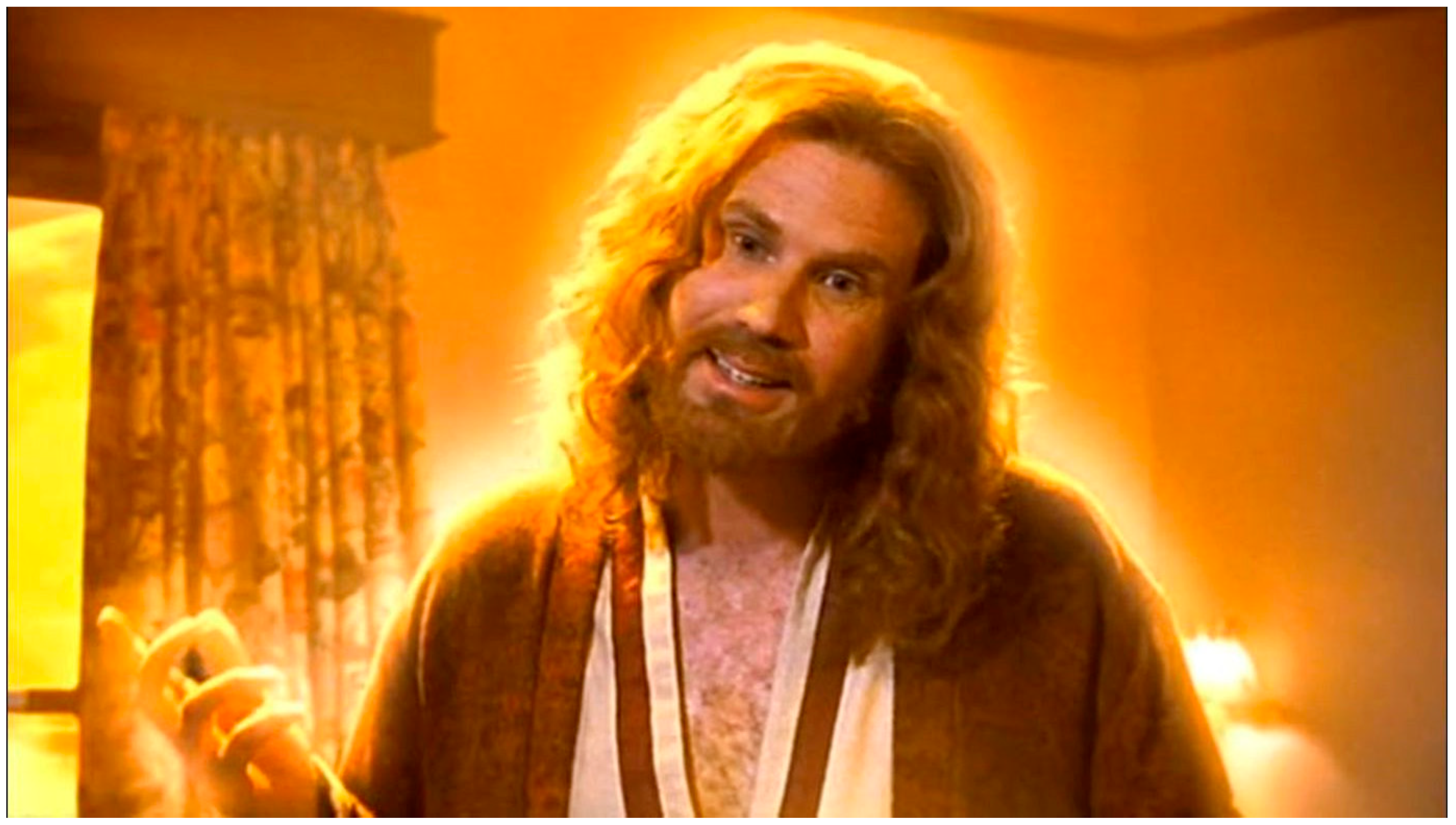


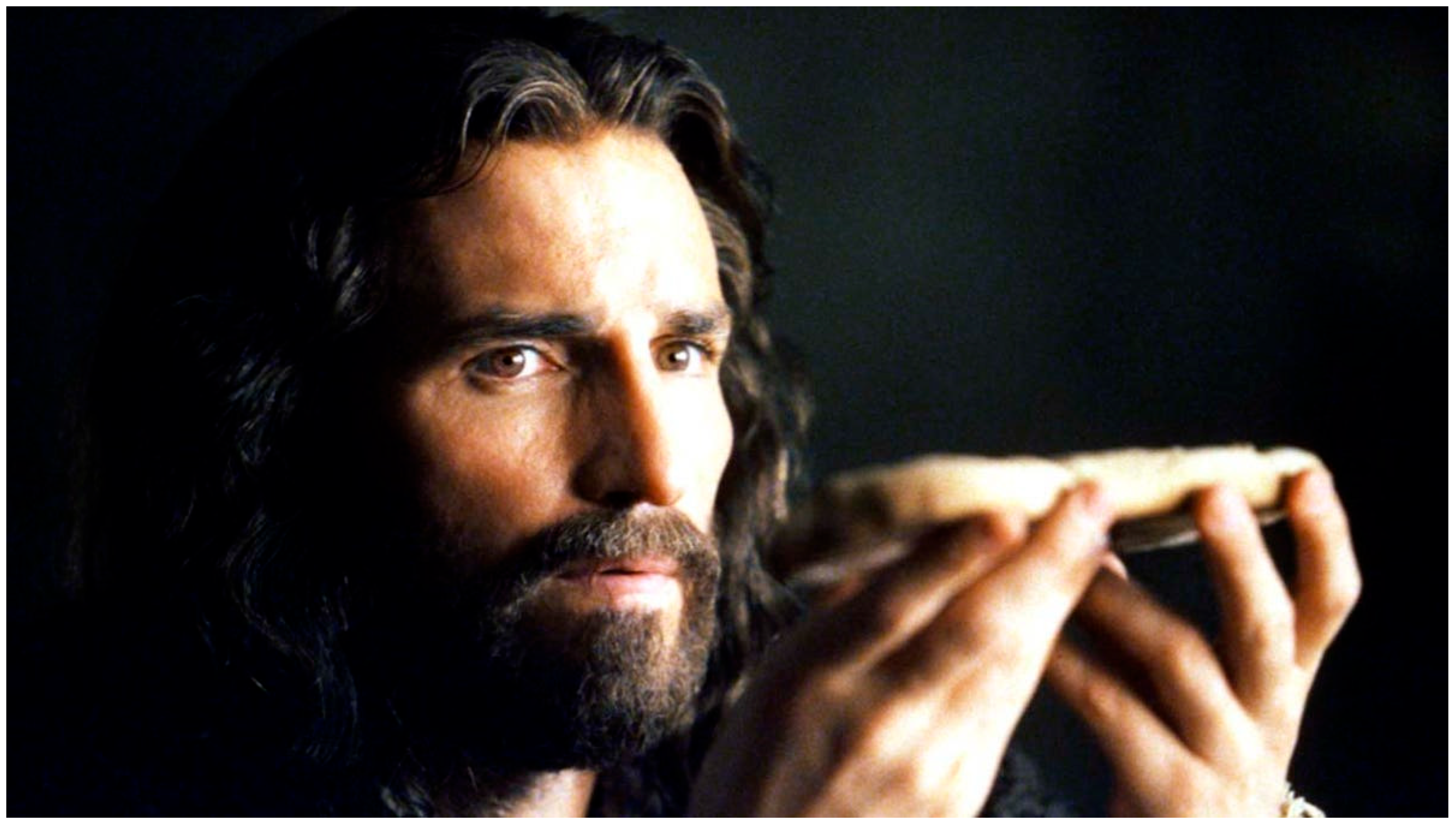




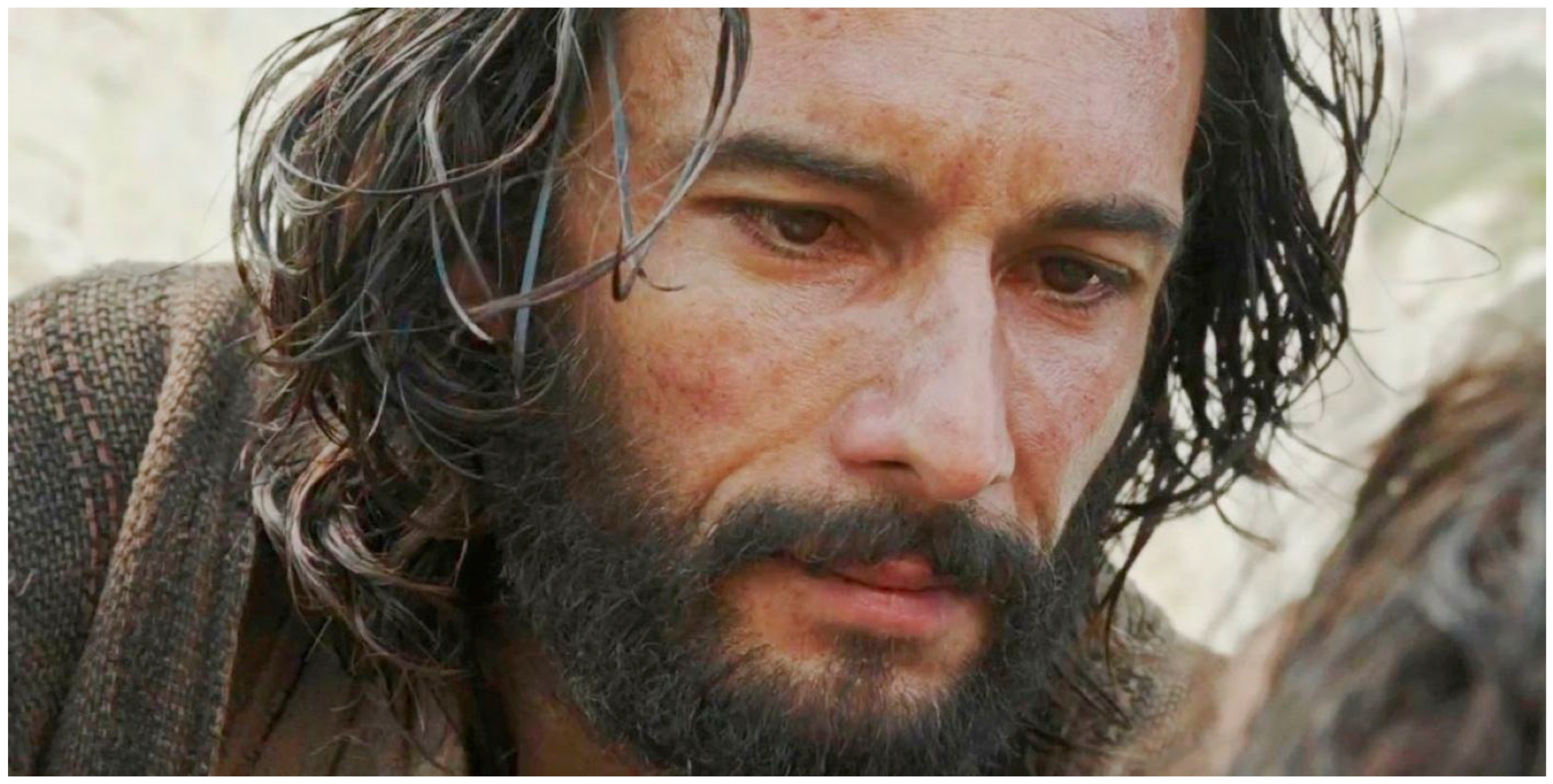


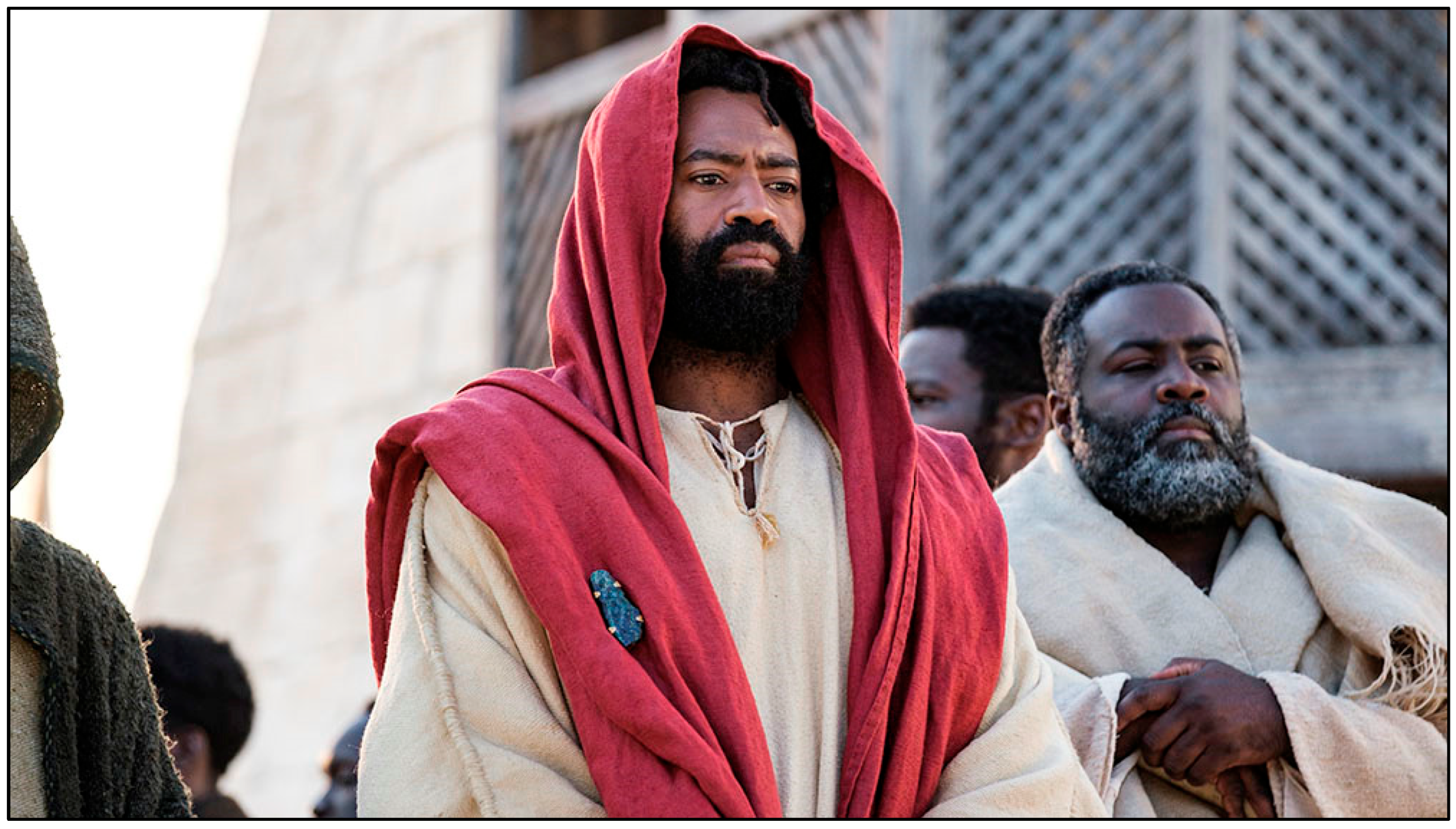
References
- Allen, Gregory Kahlil Kareem. 2008. The Word Made Cinematic: The Representation of Jesus in Cinema. Doctoral dissertation, University of Pittsburgh, Pittsburgh, PA, USA. [Google Scholar]
- Bakker, Freek. 2009. The Challenge of the Silver Screen: An Analysis of the Cinematic Portraits of Jesus, Rama, Buddha and Muhammad. Buckinghamshire: Brill, vol. 1. [Google Scholar]
- Baugh, Lloyd. 1997. Imagining the Divine: Christ-Figures in Film. London: Bloomsbury. [Google Scholar]
- Blum, Edward, and Paul Harvey. 2012. The Color of Christ: The Son of God and the Saga of Race in America. Chapel Hill: UNC Press Books. [Google Scholar]
- Bowes, William. 2022. Depictions of Jesus Christ in twenty-first century film. In Film, Philosophy and Religion. Edited by William Anderson. Edmonton: Vernon, pp. 29–49. [Google Scholar]
- Brunstad, Paul Otto. 2001. Jesus in Hollywood The Cinematic Jesus in a Christological and Contemporary Perspective. Studia Theologica-Nordic Journal of Theology 55: 145–56. [Google Scholar] [CrossRef]
- Eklund, Rebekah. 2017. Hot Jesus, Black Messiah, Suffering Son of God: How Jesus Films Shape Our Moral Imaginations. Journal of Religion & Film 21: 33. [Google Scholar] [CrossRef]
- Fear, David. 2024. The Book of Clarence rewrites the Biblical epic. Rolling Stone. January 12. Available online: https://www.rollingstone.com/tv-movies/tv-movie-reviews/the-book-of-clarence-review-lakeith-stanfield-teyana-taylor-bible-black-jesus-1234941998/ (accessed on 30 October 2024).
- Goldblatt, Roy. 2003. As plain as the nose on your face: The nose as the organ of othering. Amerikastudien/American Studies 48: 563–76. [Google Scholar]
- Jacobson, Matthew. 2020. Looking Jewish, seeing Jews. In Theories of Race and Racism. Oxford: Routledge, pp. 303–21. [Google Scholar]
- Jones, Catherine, and Atsushi Tajima. 2015. The caucasianization of Jesus: Hollywood transforming Christianity into a racially hierarchical discourse. The Journal of Religion and Popular Culture 27: 202–19. [Google Scholar] [CrossRef]
- Jütte, Robert. 2020. The Jewish Body: A History. Philadelphia: University of Pennsylvania Press. [Google Scholar]
- Kidd, Colin. 2006. The Forging of Races: Race and Scripture in the Protestant Atlantic World, 1600–2000. Cambridge: Cambridge University Press. [Google Scholar]
- Kozlovic, Anton Karl. 2004. The structural characteristics of the cinematic Christ-figure. The Journal of Religion and Popular Culture 8: 5. [Google Scholar] [CrossRef]
- Langmann, Brady. 2023. How to Watch all the Batman Movies in Order. Esquire. March 2. Available online: https://www.esquire.com/entertainment/movies/a38982310/batman-movies-in-order/ (accessed on 30 October 2024).
- Lodge, Guy. 2024. ‘The Book of Clarence’ Review: LaKeith Stanfield Is an Unlikely Messiah in Jeymes Samuel’s Brash Biblical Epic. Variety. October 12. Available online: https://variety.com/2023/film/festivals/the-book-of-clarence-review-lakeith-stanfield-1235751809/ (accessed on 30 October 2024).
- Miner, Curtis Edward. 1995. The ”Filmlical” Jesus: A Critically Evaluative Review of the Jesus Film Genre. Los Angeles: Claremont School of Theology. [Google Scholar]
- Murray, Conor. 2023. Bradley Cooper Criticized for ‘Maestro’ Prosthetic Nose to play Jewish Composer—But Leonard Bernstein’s Estate Defends Him. Forbes. August 16. Available online: https://www.forbes.com/sites/conormurray/2023/08/16/bradley-cooper-criticized-for-maestro-prosthetic-nose-to-play-jewish-composer-but-leonard-bernsteins-estate-defends-him/?sh=3bbb1af87d0b (accessed on 30 October 2024).
- Nguyen, Henry. 2010. The quest for the cinematic Jesus: Scholarly explorations in Jesus films. Currents in Biblical Research 8: 183–206. [Google Scholar] [CrossRef]
- Oliver, Willem. 2014. Reconsidering the skin color (race) of Jesus and his ancestors. Journal of Early Christian History 4: 95–115. [Google Scholar] [CrossRef]
- O’Sullivan, Michael. 2024. The Book of Clarence: The Biblically Inspired Film Mixes Faith and Farce. The Washington Post. January 8. Available online: https://www.washingtonpost.com/entertainment/movies/2024/01/08/book-of-clarence-movie-review/ (accessed on 30 October 2024).
- Rakhamilova, Zina. 2023. Hollywood Must Challenge the ‘Jew face’ Stereotype. The Jerusalem Post. August 22. Available online: https://www.jpost.com/opinion/article-755620#google_vignette (accessed on 30 October 2024).
- Rascoe, Ayesha. 2024. Director Jeymes Samuel on ‘Book of Clarence’, a Biblical Epic Through a Black Lens. [Radio Broadcast Transcript]. NPR. January 14. Available online: https://www.npr.org/2024/01/14/1224674045/director-jeymes-samuel-on-book-of-clarence-a-biblical-epic-through-a-black-lens (accessed on 30 October 2024).
- Reinhartz, Adele. 2007. Jesus of Hollywood. New York: OUP USA. [Google Scholar]
- Taylor, Joan. 2015. What Did Jesus Really Look Like? BBC News. December 24. Available online: https://www.bbc.com/news/magazine-35120965 (accessed on 30 October 2024).
- Telford, William R. 2001. The characterization of Jesus. In From Sacred Text to Internet. Edited by Gwilym Beckerlegge. Aldershot: Ashgate, pp. 267–80. [Google Scholar]
- Truitt, Brian. 2024. How the ‘Book of Clarence’ Gives a Brutal Scene from the Bible New Resonance. USA Today. January 13. Available online: https://www.usatoday.com/story/entertainment/movies/2024/01/13/book-of-clarence-movie-spoilers/72148884007/ (accessed on 30 October 2024).
- Walsh, Richard. 2003. Reading the Gospels in the Dark: Portrayals of Jesus in Film. London: A&C Black. [Google Scholar]
- Wheeler, Penny. 2014. Jesus on film: Cinema as a tool in the discovery of the Jewish Jesus. In Teaching the Historical Jesus: Issues and Exegesis. Edited by Zev Garber. London: Routledge, pp. 183–94. [Google Scholar]
- Willmore, Alison. 2024. There’s nothing else like The Book of Clarence, for better or worse. New York Magazine. January 12. Available online: https://www.vulture.com/article/the-book-of-samuel-review-unique-for-better-and-worse.html?utm_source=flipboard.com&utm_medium=social_acct&utm_campaign=feed-part (accessed on 30 October 2024).
Disclaimer/Publisher’s Note: The statements, opinions and data contained in all publications are solely those of the individual author(s) and contributor(s) and not of MDPI and/or the editor(s). MDPI and/or the editor(s) disclaim responsibility for any injury to people or property resulting from any ideas, methods, instructions or products referred to in the content. |
© 2025 by the author. Licensee MDPI, Basel, Switzerland. This article is an open access article distributed under the terms and conditions of the Creative Commons Attribution (CC BY) license (https://creativecommons.org/licenses/by/4.0/).
Share and Cite
Moore, R.C. Deconstructing the Icon: Popular and Academic (Mis)Conceptions of the Cinematic Jesus. Religions 2025, 16, 1283. https://doi.org/10.3390/rel16101283
Moore RC. Deconstructing the Icon: Popular and Academic (Mis)Conceptions of the Cinematic Jesus. Religions. 2025; 16(10):1283. https://doi.org/10.3390/rel16101283
Chicago/Turabian StyleMoore, Rick Clifton. 2025. "Deconstructing the Icon: Popular and Academic (Mis)Conceptions of the Cinematic Jesus" Religions 16, no. 10: 1283. https://doi.org/10.3390/rel16101283
APA StyleMoore, R. C. (2025). Deconstructing the Icon: Popular and Academic (Mis)Conceptions of the Cinematic Jesus. Religions, 16(10), 1283. https://doi.org/10.3390/rel16101283





